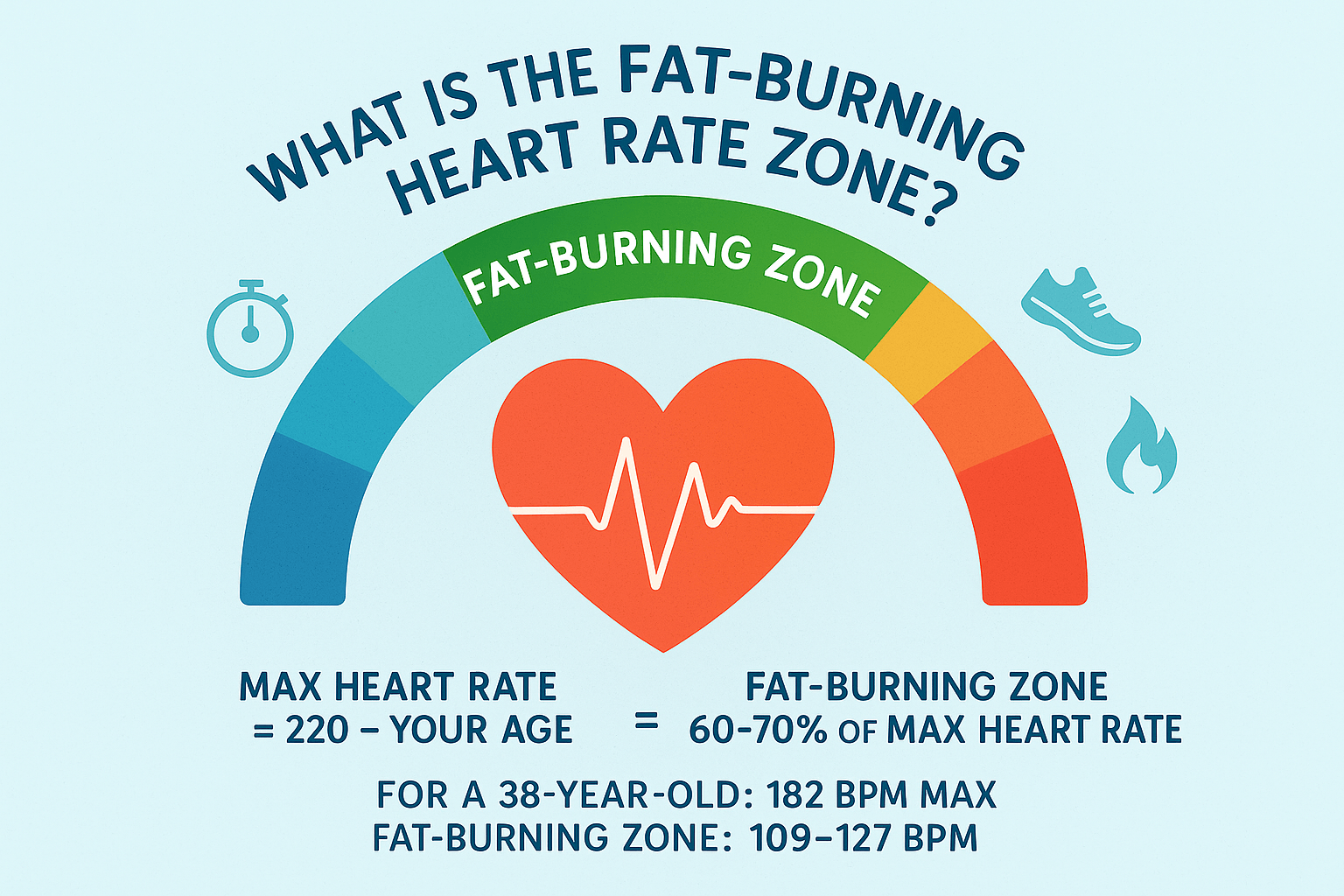Working out at a heart rate that places you in the fat-burning zone can support losing body fat. Your individual fat-burning heart rate varies based on factors like age.
Your pulse provides a gauge of exercise intensity. For most adults, the resting heart rate falls between 60 and 100 beats per minute. During physical activity, heart rate rises. The more intense the workout, the higher the heart rate climbs.
When you exercise within your fat-burning heart rate zone, the body increasingly taps into fat reserves for energy rather than relying primarily on simple sugars and carbohydrates. This shift promotes fat loss.
Other commonly referenced heart rate zones include:
- resting heart rate
- moderate heart rate
- target heart rate
- maximum heart rate
How to calculate your fat-burning heart rate
Your fat-burning heart rate typically sits at around 70% of your maximum heart rate.
Your estimated maximum heart rate is the highest number of beats your heart should reach during exercise. A simple way to estimate it is to subtract your age from 220.

For instance, a 35-year-old has an estimated maximum heart rate of 220 minus 35 — which equals 185 beats per minute.
To be in the fat-burning range, they’d aim for about 70 percent of 185, which equals roughly 130 beats per minute.
Estimating other heart rate zones
Specialists often suggest working at about 70–85% of your maximum heart rate for vigorous activity. This is commonly called your target heart rate.
A moderate heart rate generally ranges from 50 to 70 percent of your maximum heart rate.
Fat-burning heart rate chart
When using the chart below, remember that, generally, the older you are, the lower your fat-burning heart rate will be. For example, if you are 32, you would use the higher value in the 31 to 35 age bracket to estimate your fat-burning heart rate.
AgeEstimated fat-burning heart rate in beats per minute
18 to 2014021 to 25136 to 13926 to 30133 to 13631 to 35129 to 13236 to 40126 to 12941 to 45122 to 12546 to 50119 to 12251 to 55115 to 11856 to 60112 to 11561 to 65108 to 11166 to 70105 to 10871 to 75101 to 104
Certain medications can alter your heart rate, so consult a healthcare professional if you have any concerns.
Tools for tracking heart rate
There are many devices available to help you monitor heart rate during workouts and daily life. However, you don’t necessarily need high-tech gear to get a basic measurement.
Manual pulse checking
The least expensive method is to use your fingers to check your pulse. Pause your activity and place your finger over a pulse point on your neck, wrist, or chest.
Count the beats for 60 seconds (or count for 30 seconds and multiply by 2). That number is your heart rate.
Wrist-based monitors
Wristband heart rate trackers have grown in popularity because they wear like a conventional watch.
The benefit over manual checks is continuous monitoring without pausing your activity.
Many models also track steps, distance, calories burned, and floors climbed, while functioning as a regular timepiece.
Chest-strap monitors
Chest strap heart rate monitors wrap around your chest and measure your heart rate during exercise.
Some models transmit your heart rate wirelessly to a compatible device, typically a watch, giving a more comprehensive view of your session. Straps are adjustable for different body shapes.
Chest straps can often be worn for many activities, including swimming.
Before buying, check device specifications carefully. Some are fully waterproof and can be submerged, while others are merely water-resistant and suited only for brief exposure to water.
»MORE:Learn how to lose weight the healthy way, the Wellos™ wayWellos is owned by RVO Health. By clicking on this link, we may receive a commission. Learn more.
Choosing workouts that target fat-burning
The most effective exercises to reach your fat-burning heart rate differ by individual. The important thing is to monitor your pulse during various activities to determine where you fall and adjust accordingly.
For fat loss, favor moderate-intensity exercise. Use the talk test if you’re unsure about intensity. If you cannot speak during the activity, you’re likely exercising at vigorous intensity. If you’re slightly short of breath but can sustain a conversation, you’re probably at moderate intensity and might be in your fat-burning zone.
Examples of activities that may bring you into the fat-burning zone include:
- slow jogging
- brisk walking
- water aerobics
- cycling (under 10 miles per hour)
- tennis (doubles)
- ballroom dancing
While focusing on fat loss, it’s also beneficial to push into the vigorous zone occasionally. Higher-intensity efforts boost cardiovascular fitness and burn more calories than moderate exercise.
Interval workouts—alternating between walking and running, for example—can be a productive approach for shedding fat and improving cardiovascular health.
Other strategies to reduce body fat
Beyond exercise, adopting healthy daily habits can help you lose fat and lower overall weight.
Prioritize whole foods
Fill much of your plate with fruits and vegetables. Choose whole grains, lean proteins, and low-fat dairy when possible. Shop around the store’s perimeter and limit added sugars and saturated fats found in processed foods.
Stay well-hydrated
Sugary drinks like soda and juice add calories. If plain water is unappealing, try adding a splash of lemon or using a calorie-free flavoring.
Watch portion sizes
Restaurant portions are often oversized—consider requesting a take-home container and portioning half away before you eat. At home, use smaller plates; serving meals on a salad plate rather than a large dinner plate can help control portions.
Seek gradual, sustainable weight loss
Losing more than 2 pounds per week may not be safe or maintainable. A physician can advise on an appropriate goal and refer you to a registered dietitian if needed.
»MORE:Learn how to lose weight the healthy way, the Wellos™ wayWellos is owned by RVO Health. By clicking on this link, we may receive a commission. Learn more.
Takeaway
If you’re new to exercising, begin gradually to avoid injury and burnout before increasing intensity.
With time you can raise workout intensity and gain further cardiovascular and fat-loss benefits. Consistency and persistence yield results.


















Leave a Reply
You must be logged in to post a comment.